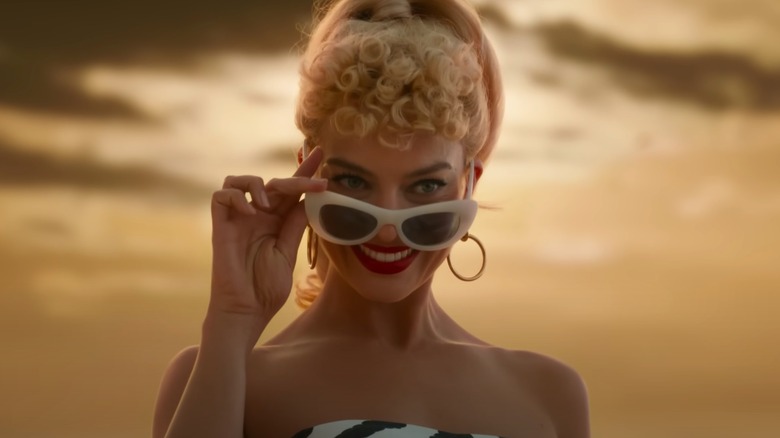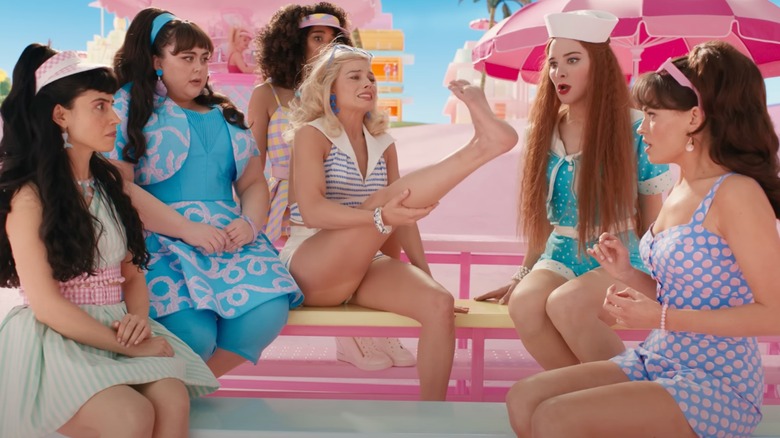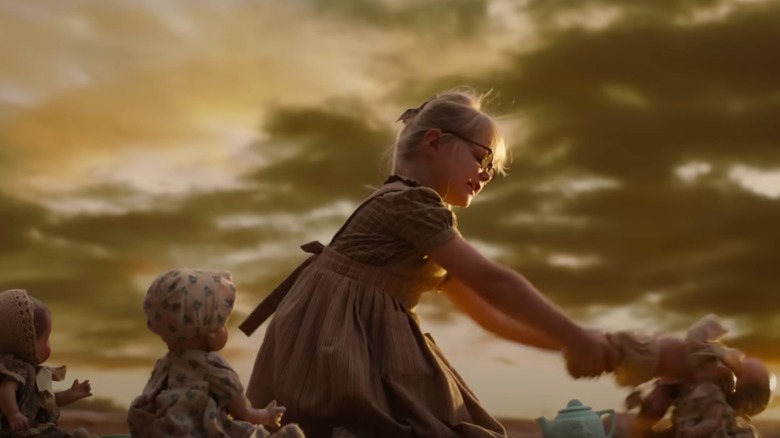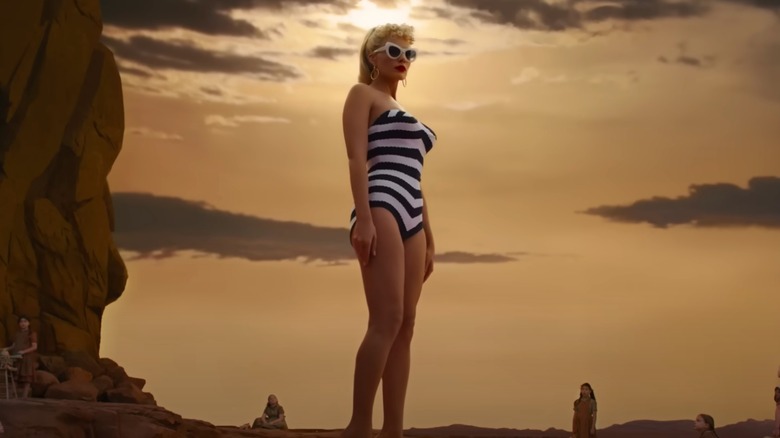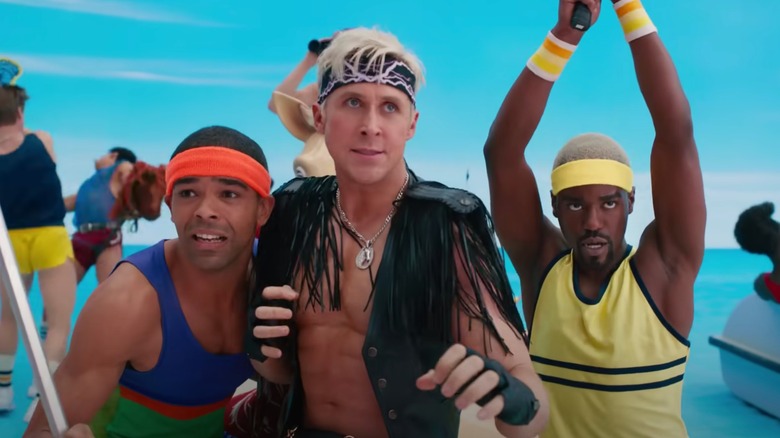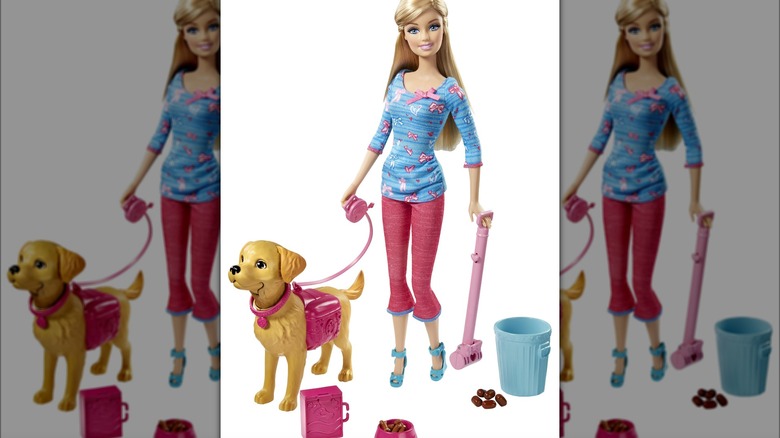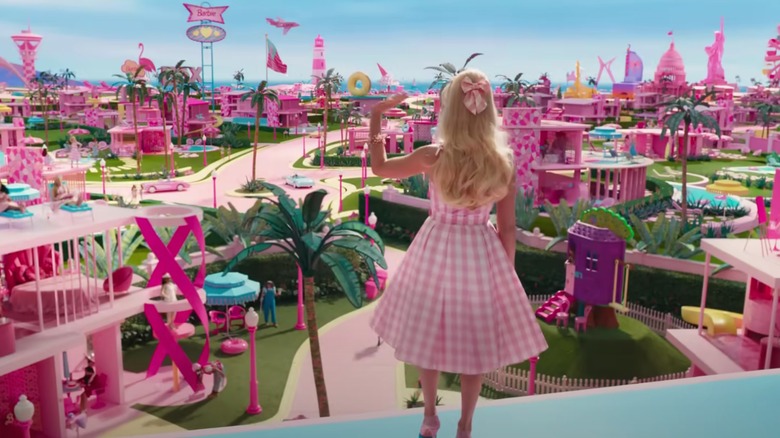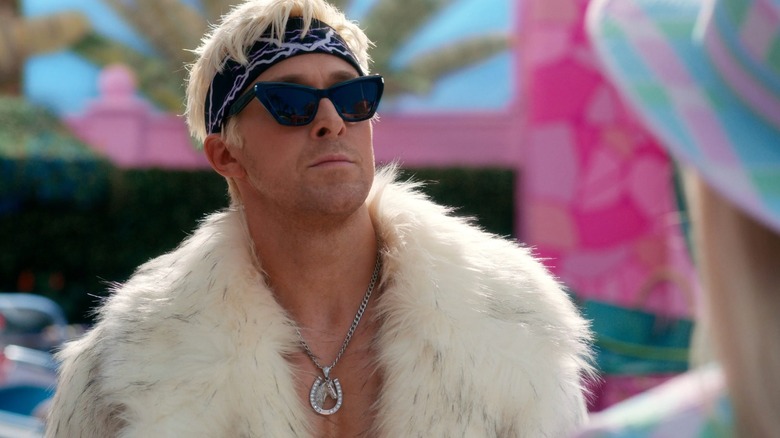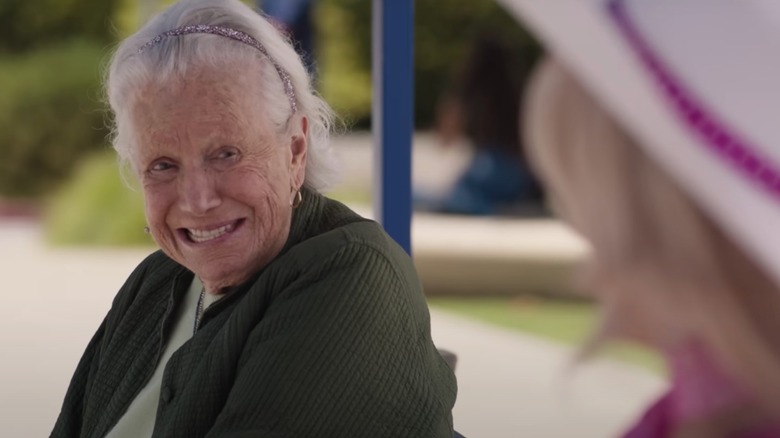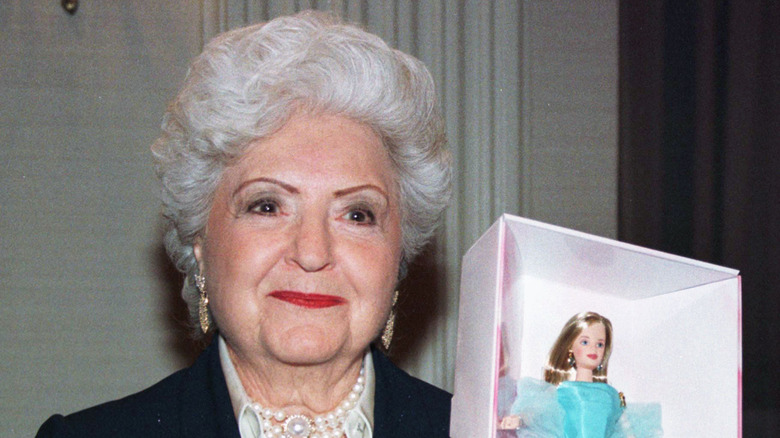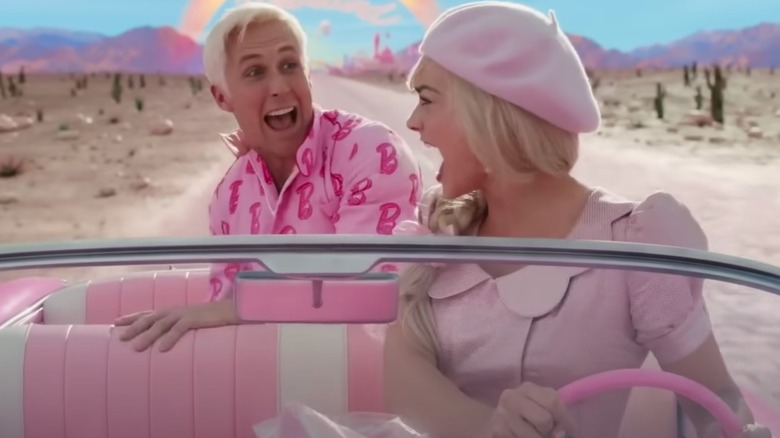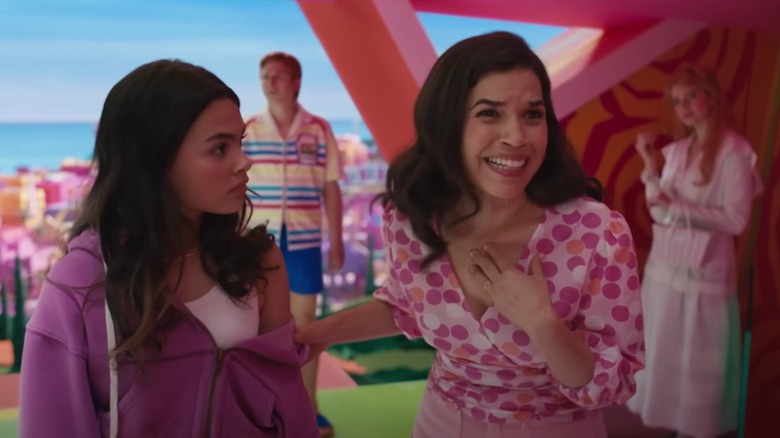Easter Eggs And References You Missed In Barbie
Contains spoilers for "Barbie"
The most anticipated movie of the summer, and arguably all of 2023, is Greta Gerwig's "Barbie." First of all, Gerwig is at the helm, and after her recent cinematic triumphs fans can be assured the film is in good hands. But it's also become a phenomenon for the way the film touches on Barbie's relationship with feminism and sense of purpose.
Gerwig manages to take all of the great aspects of Barbie — showing women that they can achieve their biggest dreams — while fully recognizing and calling attention to the negative impact the doll has, with unrealistic body standards and how it instills the idea that women have to be extraordinary to be worthy. The film is a brilliant combination of the true nature of feminism, navigating existential dread, and figuring out what makes you special, but serving as a reminder that you don't have to be the president or a Nobel Prize winner to be an incredible human.
When the film's trailer came out, fans immediately took to analyzing all the smaller details and easter eggs that Gerwig strategically placed in the film to ignite Barbie lovers' minds. Now that the film is out, fans quickly realize that most of the smaller details in "Barbie" do not go unnoticed, like Margot Robbie's unrealistic beauty, original and discontinued costumes, and meta pop culture references. However, there are some tiny easter eggs that if you blink you may miss, so check out this list of small details that subtly enhanced "Barbie."
Discontinued Dolls
One of the cool elements that Gerwig brings to the film is calling attention to the specific kinds of Barbies each character represents. Robbie's "Stereotypical Barbie" look doesn't outshine other Barbies, like Issa Rae's "President Barbie," Alexandra Shipp's "Writing Barbie," or Kate McKinnon's hilarious and loveable "Weird Barbie." However, what really piques the audience's interest is the inclusion of discontinued Barbie dolls that Gerwig includes to fully pay homage to both the triumphs and mistakes of Mattel's ideas.
For example, Michael Cera plays Allan, Ken's best buddy who was discontinued after Mattel realized that kids were not even that interested in playing with Ken, let alone his sidekick. Additionally, Emerald Fennell plays the often-forgotten Barbie bestie Midge, who is a discontinued pregnant Barbie, and often coupled with Allan.
You can see other more tame discontinued dolls like "Video Barbie," who loved television so much that she had a TV screen on her back, and "Earring Magic Ken" who has an earring and a big round necklace (which many likened to a wearable sex toy), sparking rumors that the doll is "Gay Ken" and getting it pulled from the shelves.
There are also a few other, more questionable Barbie dolls included like "Sugar Daddy Ken" (yes, this was a real Barbie doll that was discontinued for obvious reasons) and "Growing Up Skipper," which featured a slightly older version of Barbie's little sister doll that, when you turned the arm, grew a pair of boobs (yikes).
2001: A Space Odyssey Inspired Opening
One scene that was featured in the trailer and opens the film is the little girls' revolt against baby dolls. With Helen Mirren narrating, the scene is cinematically gripping — watching young girls solemnly play with their baby dolls and act as mothers, while Mirren tells the audience how little girls were always force-fed the baby doll. That is, until Barbie came on the scene, showing little girls that the role of mother was not the only aspiration they could have. As a result of seeing Robbie's powerful stance, the little girls smash their baby dolls and revolt against this motherly ideology to opt for a Barbie.
The scene might seem slightly off-putting to those who haven't seen the original source material, but the "Barbie" opening is entirely based on — and a near shot-for-shot remake of — the opening from "2001: A Space Odyssey." However, instead of an alien monolith appearing before a crowd of cavemen, Robbie's towering, beautiful 1950s swimsuit-clad presence dominates the scene. The young women are inspired by Robbie's Barbies, and instead of breaking skulls like the cavemen do, the little girls smash their baby dolls in the same intense, animalistic manner. A baby doll is thrown into the air before transitioning into the "Barbie" logo, a clear homage to Kubrick's famous match shot in "2001: A Space Odyssey" that turns a flying bone into a satellite. The entire scene is absurd in these circumstances, but manages to cover a lot of exposition to contextualize Barbie for the audience, and certainly sets the tone for the bizarre nature of the rest of the film.
Barbie's First Look
One of the key elements to perfecting the "Barbie" movie comes from recreating Barbie's iconic looks. "Barbie" costume designer Jacqueline Durran recreated more looks than you could count for the film, commenting in an interview with Vogue that the 11 weeks of production made it difficult — but not impossible — for her to pull off the range of Barbie looks she sought to include. Durran wanted to fully capture the history of the doll by recreating some of the most memorable and niche costumes for casual fans and superfans alike to enjoy. Durran started with the very first look you see Robbie's Barbie wearing: The 1959 Barbie swimsuit.
This look is featured in the "2001: A Space Odyssey" parody opening scene, with Robbie sporting a black and white one-piece swimsuit, red lipstick, blue eyeshadow, heels, and sharp sunglasses. The recreation of this look is almost identical to the earliest model of the Barbie doll. It makes sense to start the film off with Barbie's origin, and Durran absolutely nails it. However, it is abundantly clear that set design and costume design are absolute standouts in the film, so it is unsurprising that it starts off with a bang.
Ryan Gosling's Song and Dance Solo
If you are anywhere on the internet, then you have seen the video of Ryan Gosling, the beloved Ken, at 12 years old dancing in an episode of "Star Search." He stands, front and center, with a group of dancers, and absolutely tears it up for the whole audience — and now us — to see. The MC Hammer pants, the facial expressions, and everything else about the video is incredible and totally on brand. Gosling's dancing career clearly did not start with "La La Land." If you haven't seen it, you definitely need to find it immediately.
However, nothing — and we mean nothing — could prepare you for Gosling's song and dance movies in the "Barbie" movie. Gerwig truly leaned into the hype surrounding Gosling's resurfaced video and created a musical masterpiece. Ken sings about his feelings about his meaningless existence, giving the audience more insight into Barbie's male accessory. This musical number is a great callback to Gosling's younger days and gives the movie more of a quirky tone, if that's even possible. Plus, it gives Gosling more of an opportunity to steal the show, as he does throughout the whole film.
Barbie's Dog
Barbie has many sidekicks, including siblings, friends, and, of course, Ken. However, Barbie also has several pets throughout her many pieces of media, one, in particular, being a golden retriever named Tanner. One of the quick little moments in the "Barbie" movie that you might miss is the inclusion of Barbie's dog, Tanner. When Barbie goes to Weird Barbie's (Kate McKinnon) house, she finds the dog walking through the house and leaving poop pellets along the way. The dog is only present for a few seconds, but real Barbie fans recognize it right away.
One Barbie toy that was discontinued was Tanner, an accompaniment for Potty Training Barbie. When Barbie would walk the dog, it would drop poop pellets, and Barbie would have the tools to pick them up. The problem, though, was that the pellets were so small that they constituted a choking hazard for small children. Additionally, the toy was recalled because the small magnet in the scooper fell off way too easily, providing yet another safety issue for kids. This toy is one that lives in infamy, but is certainly a hilarious addition to the "Barbie" movie.
Pop Culture References
There are so many Barbie universe references throughout the film, and pretty much every single one of them is called out by Helen Mirren's narration. However, because of all of these references, it seems especially jarring when the reference being made has to do with a different piece of pop culture unrelated to Barbie. But Gerwig adds so many pop culture references to the film that it's almost a game in and of itself to find them all. Fans will notice the discussion surrounding "Pride and Prejudice" and the feminine right to watch it whenever they want, as well as the brief discussion about loving Zack Snyder's "Justice League" cut and the masculine urge to shove that in everyone's face.
However, there are some quicker and more subtle references too, like Weird Barbie offering Barbie the truth or a way to ignore everything with a high heel and a Birkenstock. This is a nod to the red pill and blue pill decision from "The Matrix." Or, in the montage sequences, there are brief clips from "The Godfather," "Grease" and other popular pieces of media. It is great to watch Gerwig give both subtle and blatant nods to popular pieces of media.
Ken's Rocky Coat
Can we get some applause for Ken's outfit choices throughout the film? Most of the focus in costume conversations surrounding the film comes from Barbie's looks, and rightfully so. However, the choices for Ken's outfits are just as incredible. In keeping with the theme of making a plethora of pop culture references throughout the film, there are many references to Sylvester Stallone, and to "Rocky" as a whole. They are mostly subtle, like a picture of him placed in the frame, but the biggest reference comes from Ken's outfit choice when he takes over Barbieland with the patriarchy in tow. His giant white fur coat and no shirt make for a bougie look — and a reference.
Sylvester Stallone wore that white fur coat in the '70s and '80s, even earning himself a GQ article about it. Gosling learns about the patriarchy, horses, and Stallone in the real world and takes all of that, including Stallone's fashion choices, back to Barbieland with him. Though the coat in the film is fake fur, costume designer Jacqueline Durran said that they lined the coat with horse print as a homage to Ken's obsession with horses upon seeing them in California. For those who are fans of Stallone, and appreciate Ken's love of horses, the coat is a nice little easter egg.
Barbara Handler's Cameo (Or Not)
There is one particularly beautiful scene in the movie that features Barbie telling an old woman at the bus stop that she is beautiful. The woman, in response, says she "knows it," giving Barbie a nice smile. The scene perfectly encapsulates what the Barbie movie is all about, and it is one of the most heartfelt moments in the film. However, fans began speculating who the woman is, and many were led to believe it was Barbara Handler, daughter of Barbie inventor Ruth Handler.
Pump the brakes, though, because that woman actually is not Barbara Handler. Instead, the woman in question is actually Oscar-winning costume designer Ann Roth, who has worked on movies like "Animal Crackers" and "The Seagull." The scene is still particularly meaningful, but does not have the connection to the Handler family that many fans speculated. Though, there is a big mention of Barbara Handler and the way she inspired Ruth to create the Barbie doll, so she is not totally absent from the film.
Ruth Handler's Tax Evasion
Though Barbara Handler was not actually featured in the film, Gerwig found a way to put her mother Ruth Handler in the film. Gerwig's cool way of paying homage to Barbie's inventor is by having Rhea Pearlman play Ruth in the film. This is not just a glorified cameo either — Handler and Barbie have a nice conversation at the end of the film about humanity and their relationship with one another. However, the inclusion of Handler featured a couple of quick jokes regarding Handler's tax evasion, which fans might not understand if they weren't in the loop on the Barbie inventor's finances.
In the 1970s, Handler was indicted after charges of fraud and false reporting to the Securities and Exchange Commission were brought to light. She pleaded no contest and was fined $57,000. In addition, she had to serve 2500 hours of community service. Because there were no serious consequence (her punishment could have been much worse), it is something people feel comfortable joking about, and so of course Gerwig would use that as a quick quip for those familiar with Handler's history.
Barbie and Ken's Creation Myth
Gerwig is able to explore many themes in the film, particularly about feminism, coping with existence, and trying to find your individuality in a world that demands you to be perfect or extraordinary always. However, one more subtle, interesting theme that Gerwig tackles throughout the "Barbie" movie comes from her exploration of the way Barbie and Ken are attached to one another, and who Ken is without Barbie. A lot of the film revolves around Barbie's crisis with who she is and what she was made for, while Ken's crisis is learning about how he can be his own person and not only exist as something other than an extension of Barbie. It functions as an interesting take on the creation myth in Genesis, and how their relationship is like Adam and Eve, but flipped.
Barbie was invented as a way of empowering women. As a result, Ken was created after Barbie to essentially function as a human accessory to her. Gerwig found a way to explore how Ken burnishes Barbie's self in the eyes of those who play with her, similar to the creation myth that Eve was created from Adam's rib. Gerwig emphasizes this in reverse with Barbie and Ken, showcasing how Ken was created from Barbie's fame.
America Ferrera Si Se Puede
Though most of the "Barbie" movie focus comes from Robbie and Gosling's performances, it's important to acknowledge how incredible the entire cast is, particularly America Ferrera. She perfectly encapsulates what it is like to be a woman, and the intense pressure women are under to successfully make it through even one day. Her acting is lovely, her obsession with Barbie is relatable, but we're not here to talk about that. We're here to talk about the quick little quip at the end of the movie referencing one of Ferrera's older, iconic films: "Gotta Kick It Up."
Ferrera's character, Gloria has to help Barbie get Barbieland back from the Kens. Meanwhile, her husband is learning Spanish to better connect with his wife and daughter, and says "Si Se Puede" to Barbie at the end of the film. Though the comment is one of encouragement, essentially meaning "you can do it," it is more of a nod to Ferrera's Disney film, "Gotta Kick It Up," which is alternately titled "Si Se Puede." The reference could also extend to Ferrera and Eva Longoria's digital lifestyle community for Latinx people called "She Se Puede."
